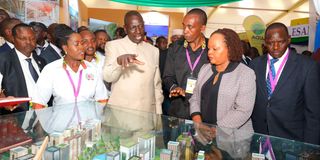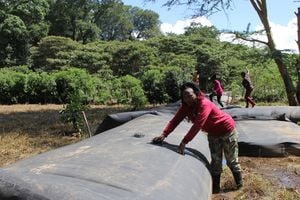Anne Waiguru highlights counties’ wins in 10 years of devolution

President William Ruto (centre) is shown a model of the proposed Thika Industrial Smart City in Eldoret yesterday. With him are Kirinyaga Governor Anne Waiguru (second right) and Kiambu Governor Kimani Wamatangi (third right).
Council of Governors (CoG) chairperson Anne Waiguru on Wednesday took to the podium at the eighth devolution conference to highlight some of the achievements county governments have made since 2013.
The inaugural biennial summit, which was officially opened by President William Ruto, brought together over 10, 000 local and international delegates to evaluate the hits and misses a decade since the introduction of the devolved system of governance and to deliberate on the future.
“As a good student of the Bible, I must start with thanksgiving to the national government for the end-of-year disbursements which were on time. Counties have also received their dues for July, which is the first time in the history of devolution,” Ms Waiguru told delegates. She said the timely disbursement by the Exchequer signalled commitment by the national government to support devolution.
The Kirinyaga governor said the conference was happening just as the nation was recovering from the devastating effects of the Covid-19 pandemic that made 2020 and 2021 difficult years.
She described the devolution journey as one fraught with highs and lows, which have been surmounted through dialogue while reminiscing her tenure as a cabinet secretary.
“Between 2017 and 2022 ... we experienced more order and stability and relations between the two levels of government somewhat improved,” she said.
Since then, she observed, counties have experienced successes in various sectors.
“For the first time since independence, Mandera County performed its first caesarean delivery at Takaba Sub-county Hospital in 2014. In Samburu County, maternal deaths have over the past ten years declined by over 79 per cent because the county government built houses within health facilities for expectant mothers to move in with their families, weeks before delivery,” she observed.
She said in 2013, there were 8,466 health facilities across the country and by 2022 the number has increased to 13,722.
In agriculture, the counties have been allocating an average of 7.3 per cent of their budgets to the sector, she said. She cited the number of dairy animals, which had increased to 170,000 by last year while milk production had increased by 30 per cent and extension services covered 3.9 million farmers. Ms Waiguru said that, as of 2022, counties had registered 124,420 micro-enterprises, 87,153 small enterprises, and 34,727 medium enterprises.
“To support these businesses, counties have set up Enterprise Funds that have benefited over 7,000 [small businesses] through loans and grants,” she said.
Ms Waiguru said counties are at the forefront in promoting the adoption of climate-smart technologies and solutions, citing Kilifi, which was leading efforts to conserve the environment by encouraging residents to reduce charcoal use and turn to briquettes.
She also highlighted challenges, such as a shortage of funds, misalignment of policies, laws, and administrative actions, slow implementation of intergovernmental decisions, ineffective management of human capital, and slow implementation of intergovernmental decision.





